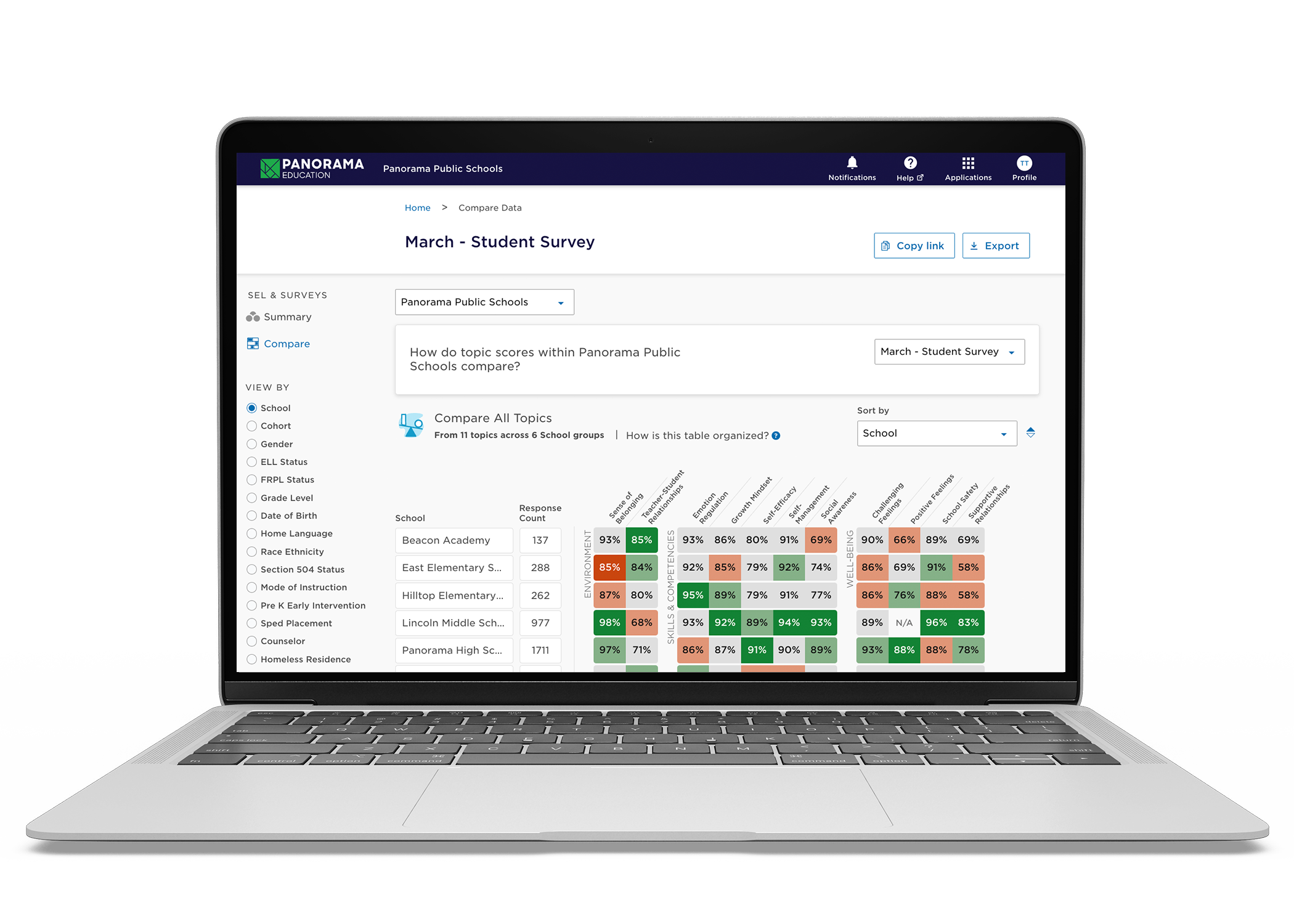Understanding the experiences and perceptions of students, families, and staff is more critical than ever. District leaders face unprecedented challenges, from addressing chronic absenteeism to closing learning gaps that have widened over the past few years. By tapping into the voices of students, families, and staff, districts can better understand and respond to these critical issues, ensuring that the needs of the community inform every decision.
To gather this authentic, actionable feedback from their community, many districts are turning to feedback surveys. Feedback surveys are essential for gathering valuable insights that can drive meaningful improvements in schools and districts. By collecting and analyzing feedback, educational leaders can make informed decisions that enhance student outcomes, foster a positive school climate, and build stronger community partnerships.
Whether you’re looking to start a new survey program or enhance an existing one, this guide will walk you through every step, from understanding the importance of feedback surveys to leveraging the data for continuous improvement.
We'll explore the key elements of successful survey programs, provide practical tips for creating and running surveys, and offer strategies for analyzing and using the collected data. Additionally, you'll find inspiring case studies from districts that have successfully harnessed the power of feedback surveys to drive positive change.
Table of Contents
Why Are Feedback Surveys Important?
Elements of an Effective Survey Program
How to Create and Run a Survey Program
Case Studies of Top-Notch Survey Programs
Next Steps for School & District Leaders
Why Are Feedback Surveys Important?
Importance of Gathering Feedback
Feedback surveys play a pivotal role in a district’s continuous improvement process. By gathering input from students, families, and staff, schools and districts can gain a deeper understanding of their needs, experiences, and perceptions. This valuable information is crucial for several reasons:
-
Enhancing Student Engagement and Learning Outcomes: Feedback from students helps educators understand what is working and what isn't in the classroom. This understanding can lead to adjustments in teaching methods, curriculum design, and support services, ultimately boosting student engagement and academic performance.
-
Valuing Student Voice: When students feel their voices are being heard—and acted on—their connection to school strengthens. That increased engagement can make a big difference on attendance, academic performance, and student behavior.
-
Building Stronger Relationships With Families: Surveys provide a platform for families to voice their opinions and concerns. They foster a sense of inclusion and partnership, creating a more collaborative and supportive school community.
-
Listening and Responding to Teacher and Staff Needs: When gathered regularly, feedback from teachers and staff can help administrators prioritize supports, deliver targeted professional development, and create a more positive working environment that benefits both adults and students.
-
Informing Decision-Making Processes: Data from feedback surveys offers a solid foundation for making informed decisions at both the school and district levels. This foundation ensures that policies and initiatives are grounded in real-world insights and address the actual needs of the community.

Panorama Student Survey (demo data displayed)
Benefits of Feedback Surveys
Implementing a robust feedback survey program offers a range of benefits that contribute to overall school and district success:
-
Identifying Areas of Improvement: Surveys help identify specific areas where schools and districts can enhance their practices. Whether it's improving classroom instruction, student services, or school facilities, feedback provides actionable insights for targeted interventions.
-
Recognizing Successes and Best Practices: Feedback isn't just about highlighting problems but also about recognizing what works well. Celebrating successes and best practices can boost morale, encourage positive behaviors, and serve as models for other buildings.
-
Promoting a Culture of Continuous Improvement: Regularly seeking and acting on feedback demonstrates a commitment to continuous improvement. This culture encourages everyone in the school community to strive for excellence and remain adaptable to changing needs and challenges.
By understanding the importance and benefits of feedback surveys, educational leaders can create more responsive and effective educational environments. In turn, improved learning environments lead to better student outcomes, greater satisfaction among families and staff, and stronger, more cohesive school communities.
Elements of an Effective Survey Program
Clear Objectives
An effective survey program starts with clear objectives. Establishing what you want to achieve with your survey ensures that your questions are focused and relevant, leading to actionable insights for your district.
-
Setting Goals: Begin by determining the specific outcomes you want from the survey. Are you aiming to improve student engagement, enhance teacher performance, or increase family engagement? Clear goals help guide the entire survey process.
-
Aligning With Priorities: Ensure your survey goals align with district and school priorities. When survey objectives are in sync with broader educational goals, it becomes easier to gain support from stakeholders and integrate survey results into strategic planning.
Survey Design
The design of your survey significantly impacts the quality and usability of the data collected. A well-designed survey can lead to high response rates and reliable data.
-
Crafting Questions: Use clear, concise, and unbiased language in your questions, and consider the reading level of participants taking the survey. Avoid leading or loaded questions that might skew the responses. Include a mix of open-ended and closed-ended questions to capture both quantitative and qualitative data. Open-ended questions provide rich, detailed feedback, while closed-ended questions are easier to analyze statistically.
-
Inclusivity and Accessibility: Ensure that the survey is accessible to all respondents. Make accommodations for respondents with disabilities and provide translations for non-native English speakers. Consider cultural differences and ensure questions are respectful and inclusive, promoting honest and diverse feedback.
-
Selecting Topics: Knowing which survey topics are correlated with broader concerns and goals—such as attendance or academic success—is key to developing an actionable survey. Aligning survey content with goal setting or strategic planning helps ensure the data gathered are as impactful as possible. At Panorama, we recommend selecting five to seven topics per survey. By selecting the right number of topics, you can ensure the survey aligns with your district’s goals.
-
Using Valid and Reliable Survey Instruments: Validity and reliability are two key attributes of a strong survey instrument, ensuring that the data collected is accurate, consistent, and actionable. Validity refers to whether a survey measures what it is supposed to measure. Reliability, on the other hand, refers to the consistency of the survey results over time or across different groups of respondents. A reliable survey provides stable and consistent data when administered under similar conditions. Together, validity and reliability are essential for making informed, data-driven decisions.
Frequency and Timing
The timing and frequency of your surveys can affect response rates and the quality of feedback.
-
Optimal Timing: Choose a time that is convenient for respondents, avoiding busy periods like the start or end of the school year. Mid-semester or mid-year often works well, as it provides a balance between respondents being settled in and avoiding end-of-period stress.
-
Balancing Frequency: Avoid survey fatigue by spacing out surveys and only conducting them as frequently as necessary to gather meaningful data. Over-surveying can lead to lower response rates and less thoughtful feedback. A well-timed annual or bi-annual survey can be effective, supplemented with occasional shorter, targeted surveys or Check-Ins.
By focusing on these elements, you can design an effective survey program that yields high-quality, actionable data. Clear objectives, thoughtful survey design, and appropriate timing ensure that your feedback process is both efficient and impactful, providing valuable insights to drive continuous improvement in your school or district.
How to Create and Run a Survey Program
Planning Your Survey
A well-planned survey program ensures a smooth implementation and high response rates. By addressing the key elements of planning, you can set your survey up for success.
-
Identifying Stakeholders: Determine who will be involved in the survey process. Include those who will design, distribute, and analyze the survey. Engage a diverse group of stakeholders, such as administrators, teachers, students, and parents, to ensure the survey addresses various perspectives and needs. Identify the target respondents. Decide whether your survey will target students, families, staff, or a combination of these groups. Tailoring your survey to specific audiences ensures that the questions are relevant and meaningful to the respondents.
-
Selecting Tools: Choose the right platform and tools for survey creation and distribution. Look for features like anonymity, easy data export, user-friendly interfaces, and the ability to handle various question types. Popular survey tools include SurveyMonkey, Google Forms, and the Panorama survey platform, which we’ve designed specifically for educational settings.
Communication Strategy
Effective communication encourages participation by ensuring respondents understand the purpose of the survey. A well-executed communication plan can significantly boost response rates and the quality of feedback.
-
Promoting the Survey: Use multiple channels to promote the survey. Consider emails, newsletters, school websites, social media, and in-person announcements. Clearly communicate the purpose of the survey and how you will use the feedback to make improvements. Consider personalizing invitations when possible—this can increase engagement by making respondents feel that their input is valued.
-
Providing Instructions: Offer clear instructions on how to complete the survey, including deadlines and any necessary technical support. Make sure respondents know how to access the survey and who to contact if they encounter any issues. Emphasize the importance of honest and thoughtful feedback. Assure respondents that their responses will be confidential and will be used to make meaningful improvements.
Implementation
Smooth implementation ensures high participation rates and quality data collection. By paying attention to logistical details, you can create a seamless survey experience for respondents.
-
Administering the Survey: Distribute the survey efficiently, ensuring all targeted respondents receive it. Use email lists, student portals, and other reliable distribution methods. Provide reminders as the deadline approaches to encourage participation. Provide support for respondents who may need help completing the survey. This support can include technical assistance, language translation services, and accommodations for respondents with disabilities.
-
Ensuring Privacy: Protect respondent confidentiality and ensure that data is securely stored and handled. Use encryption and other security measures to safeguard survey responses. Clearly communicate your privacy policies to reassure respondents that you will protect their data. Anonymize responses where appropriate to encourage honest and candid feedback. Assure respondents that you will not be able to trace their responses back to them unless they choose to provide their identity.
By carefully planning and effectively communicating and implementing your survey, you can maximize participation and collect high-quality data. These steps are crucial for creating a survey program that provides valuable insights and drives positive change in your school or district.
Analyzing Your Survey Data
Data Collection
Efficient data collection methods are essential for organizing responses and ensuring the data is ready for analysis.
- Organizing Responses: Use technology to gather and organize survey responses automatically. Many survey platforms offer built-in tools for data collection and initial organization, making it easier to handle large volumes of data. Ensure data is cleaned and prepared for analysis. This process includes checking for duplicate responses, incomplete submissions, and other inconsistencies that might affect the quality of the data.
Data Analysis Techniques
Proper analysis techniques are crucial for extracting meaningful insights from survey data. Use both quantitative and qualitative methods to provide a comprehensive understanding of the feedback.
Quantitative Analysis:- Use statistical methods to analyze closed-ended questions. Calculate averages, percentages, and distributions to identify trends and patterns. Tools like Excel, Google Sheets, or specialized survey software can help with this.
- Look for correlations and significant differences in responses among different groups. These can help identify specific areas of concern or success among various demographics, such as grade levels, departments, or student groups.
- Analyze open-ended responses for themes and insights. This analysis involves coding the responses to identify common themes, sentiments, and key phrases.
- Identify quotes and anecdotes that illustrate broader trends. These qualitative insights provide context and depth to the quantitative data, offering a richer understanding of the respondents' perspectives.
- Panorama AI offers several features to boost your district’s qualitative analysis of student responses. For example, Panorama Signal rapidly sorts hundreds of thousands of Survey responses to identify sensitive content. This data includes references to self-harm, abuse, threats to others, bullying, personally identifiable information, and inappropriate language. That means administrators and educators can take immediate action for students in need.
- Additionally, Panorama Community Voice synthesizes all of your free responses to instantly identify what’s important to your district and school community. Identify positive, neutral, and negative themes, and then double-click into each theme to read through the responses.

Panorama Community Voice (demo data displayed)
Reporting and Visualization
Clear reporting and visualization make it easier to communicate findings to stakeholders and ensure the data is actionable.
Creating Reports:- Develop concise and actionable reports that highlight key findings and recommendations. Structure your reports to address the main objectives of the survey and provide clear answers to the questions posed.
- Include an executive summary that presents the most important insights in a brief, easily digestible format. This summary helps busy stakeholders quickly grasp the main points.
- Use charts, graphs, and other visualization tools to make data more accessible and understandable. Visual representations can help highlight trends, comparisons, and significant findings in a way that is easy to interpret.
- Tailor visualizations to your audience. Ensure that the chosen formats are suitable for the intended stakeholders, whether they are educators, administrators, parents, or students.
By effectively collecting, analyzing, and reporting your survey data, you can transform raw feedback into actionable insights. This process is crucial for understanding the needs and perspectives of your school community and making informed decisions that drive continuous improvement.
How to Use the Survey Data
Data Inquiry Strategies
Now that your team has prepared to engage with the data, it's time to review the survey results and interpret survey data so your school and district teams can make data-informed decisions. There are many different strategies for interpreting survey data. Panorama Playbook, for example, provides a number of ways to view and interpret data, both through inquiry and elevating student voices:
-
Ladder of Inference: As you prepare to review the data, take a moment to familiarize yourself with the ladder of inference. Popularized by Peter Senge's The Fifth Discipline, the ladder of inference is a mental model for reducing bias while understanding and analyzing data. The key is to climb slowly up the ladder of inference, spending more time observing the data. Then, consider alternative explanations in the data before deciding what it means and choosing a course of action.
-
Aspirations & Apprehensions: While feedback data is an informative tool for improving practice, the process of reflecting on results can sometimes be challenging or uncomfortable. Acknowledging and sharing our aspirations and apprehensions for using student feedback can set the stage for the most positive and productive action planning. This strategy guides educators through the process of reflecting on student voice data in an objective and asset-based manner.
Action Planning
Turning survey insights into action plans ensures that feedback leads to tangible improvements. An effective action plan prioritizes areas of focus and outlines clear steps to address identified issues.
Developing Plans:-
Create detailed action plans based on survey findings. Begin by identifying key areas that need improvement and setting specific, measurable goals for each area. Break down these goals into actionable steps that you can implement over time.
-
Prioritize actions based on impact and feasibility. Focus first on changes that will have the most significant positive effect and that you can realistically achieve within your resources and timeline.
-
Establish realistic timelines for implementing changes and improvements. Clearly define start and end dates for each action step and ensure that you communicate timelines to all stakeholders involved.
-
Monitor progress against these timelines regularly to keep the action plan on track. Be sure to allow for adjustments as needed to address any challenges that arise.
Engaging Stakeholders
Involving stakeholders in the process fosters a sense of ownership and collaboration. Effective engagement ensures that the survey data informs decisions and reflects the needs and perspectives of the entire school community.
Sharing Results:-
Communicate survey results with students, families, and staff through meetings, reports, and presentations. Transparency in sharing results builds trust and demonstrates a commitment to using feedback for improvement.
-
Use different formats to reach diverse audiences. Consider including visual presentations for meetings, detailed written reports, or summary emails and newsletters.
-
Work with stakeholders to develop solutions and strategies based on survey feedback. Engage teachers, students, parents, and other community members in brainstorming sessions, focus groups, and workshops to co-create action plans.
-
Encourage open dialogue and input. Make it clear that you value all voices and that the goal is to create collaborative solutions that benefit the entire school community.
Continuous Improvement
Incorporating feedback into a continuous improvement cycle ensures ongoing progress and adaptation. Regularly reviewing and acting on survey data helps maintain a culture of excellence and responsiveness.
Monitoring Progress:-
Regularly check the progress of action plans and adjust strategies as needed. Use follow-up surveys, check-ins, and progress reports to evaluate the effectiveness of implemented changes and to identify any new issues that may arise.
-
Celebrate successes and milestones. Recognizing and rewarding progress helps maintain motivation and demonstrates the positive impact of feedback-driven improvements.
-
Use feedback surveys as an ongoing tool for continuous improvement. Regularly update and refine your survey approach to ensure it remains relevant and effective in capturing the most important data.
-
Incorporate feedback cycles into your regular planning processes. Make surveys a routine part of evaluating programs, initiatives, and overall school performance, ensuring that you continuously gather and act on valuable insights.
By effectively using survey data, schools and districts can drive meaningful improvements that enhance educational outcomes and foster positive, responsive school environments. Action planning, stakeholder engagement, and a commitment to continuous improvement ensure that the insights gained from surveys lead to tangible benefits for students, families, and staff.
Case Studies of Top-Notch Survey Programs
-
Fostering Growth Mindset at a 2023 Blue Ribbon School: How Maunawili Closed the Achievement Gap: Learn how Maunawili Elementary, a 2023 National Blue Ribbon School in Kailua, Hawaii, closed the achievement gap and improved students’ sense of belonging by 17 points.
-
Using Panorama Surveys to Empower Students at Highline Public Schools: Highline Public Schools, located just outside of Seattle in Burien, WA, serves a diverse population of 18,000 students in 34 schools. Learn how district leaders use student voice data to empower and engage students as co-creators of a new SEL program.
-
How Gadsden ISD Uses Student Voice to Adopt New Mexico’s MLSS Framework: Learn how Gadsden Independent School District—a district of 28 schools and 12,620 students—uses student voice data to inform and implement their MLSS.
-
How Feedback Surveys Helped La Cañada Unified School District Significantly Improve Communication With the Community: Five years ago, the community and Board of Education wanted access to more data, more communication, and greater transparency from LCUSD. Today, 85% of the community report satisfaction with communication from the district. Over 90% of parents of students in grades 7-12 would recommend LCUSD to other families.
Next Steps for School & District Leaders
Feedback surveys are a powerful tool for driving positive change in schools. By systematically gathering and analyzing feedback from students, families, and staff, schools and districts can make informed decisions that enhance educational outcomes, foster a supportive environment, and build stronger community relationships.
We’re excited for you to use the knowledge and tools in this guide to design, implement, and utilize feedback surveys effectively. We know your efforts will ensure continuous improvement and growth for all.
If your school or district is searching for a surveys platform, consider Panorama Surveys and Engagement. Panorama Surveys and Engagement is the leading K–12 platform for all your district's survey needs, from benchmark surveys to pulse checks. Panorama is the central place for districts to collect and analyze student, family, and teacher feedback on the factors that are critical to student achievement. With reliable, actionable feedback data, districts can address key issues like belonging, teacher-student relationships, engagement, and school safety.
Designed by an expert research team, Panorama’s reporting platform is based on a robust dataset of over 1.5 billion responses to our surveys—the largest dataset of its kind. This provides powerful benchmarking, such as insight into how your students compare to their peers and how your school or district compares to other similar communities.







